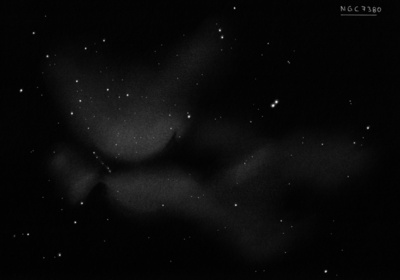
Caroline Herschel discovered NGC 7380 = H VIII-77 = h2182 on 7 Aug 1787 with her 4.2" comet-sweeper reflector. William rediscovered it on 1 Nov 1788 (sweep 876) as "a Cl of coarsely scattered stars 7' or 8' diameter." His position is accurate. John Herschel called it "a L, p rich, v coarse cl of stars 9.10 m and below." On a second sweep he noted "A double star, the chief of a fine, p rich, L cluster, 10' dia; stars 9...13m."
300/350mm - 13" (10/26/80): ~30-35 stars in a triangular outline, 10'-12' in diameter but not rich.
400/500mm - 17.5" (10/30/99): at 100x with an OIII and UHC filter appears as a bright triangular-shaped nebulosity (Sh 2-142), 8'-10' diameter, superimposed on a rich cluster of stars (NGC 7380) within a rich Milky Way field. The brightest member, mag 8.5 DH Cep, a very rare spectroscopic eclipsing pair of massive O5.5/O6.5-type stars, is at the west vertex. Also a wide strip of nebulosity is attached near the southeast vertex and extends to the southwest. A dark band appears to separate this strip from the triangular patch. The surrounding region appears weakly nebulous and the "edge" can be traced with some certainty further the north. DH Cep is the main ionizing source of the nebula.
17.5" (7/31/92): at 100x, about 40 stars in a 10' diameter. The brighter stars form a "V" or chevron pattern. The brightest star is at the west tip of the "V" and is an unequal double mag 8.6/13. The cluster appears to be encased in nebulosity especially from the mag 8.6 star to the star at the east tip of the "V". Using an OIII filter the nebulosity is quite prominent with some structure and encases the entire cluster. A lane of nebulosity oriented SW-NE extends beyond the cluster from the star at the east end of the "V" and nebulosity also extends west of the mag 8.6 star. The double star O∑480 = 7.6/8.6 at 30" is in the field to the west.
Notes by Steve Gottlieb